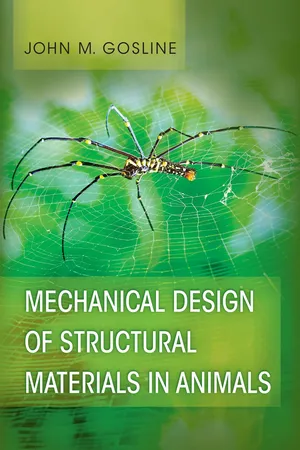
- 400 pages
- English
- PDF
- Available on iOS & Android
Mechanical Design of Structural Materials in Animals
About this book
Mechanical Design of Structural Materials in Animals explores the principles underlying how molecules interact to produce the functional attributes of biological materials: their strength and stiffness, ability to absorb and store energy, and ability to resist the fatigue that accrues through a lifetime of physical insults. These attributes play a central role in determining the size and shape of animals, the ways in which they can move, and how they interact with their environment. By showing how structural materials have been designed by evolution, John Gosline sheds important light on how animals work.
Gosline elucidates the pertinent theories for how molecules are arranged into macromolecular structures and how those structures are then built up into whole organisms. In particular, Gosline develops the theory of discontinuous, fiber-reinforced composites, which he employs in a grand synthesis to explain the properties of everything from the body wall of sea anemones to spiders' silks and insect cuticles, tendons, ligaments, and bones. Although the theories are examined in depth, Gosline's elegant discussion makes them accessible to anyone with an interest in the mechanics of life.
Focusing on the materials from which animals are constructed, this book answers fundamental questions about mechanical properties in nature.
Frequently asked questions
- Essential is ideal for learners and professionals who enjoy exploring a wide range of subjects. Access the Essential Library with 800,000+ trusted titles and best-sellers across business, personal growth, and the humanities. Includes unlimited reading time and Standard Read Aloud voice.
- Complete: Perfect for advanced learners and researchers needing full, unrestricted access. Unlock 1.4M+ books across hundreds of subjects, including academic and specialized titles. The Complete Plan also includes advanced features like Premium Read Aloud and Research Assistant.
Please note we cannot support devices running on iOS 13 and Android 7 or earlier. Learn more about using the app.
Information
Table of contents
- Cover
- Title
- Copyright
- Contents
- Preface
- SECTION I: BACKGROUND
- SECTION II: THE STRUCTURAL BASIS FOR MATERIAL PROPERTIES
- SECTION III: THE MECHANICAL DESIGN OF TENSILE MATERIALS
- SECTION IV: THE MECHANICAL DESIGN OF RIGID MATERIALS
- SECTION V: THE MECHANICAL DESIGN OF PLIANT BIOMATERIALS
- SECTION VI: CONCLUDING COMMENTS
- List of Symbols
- Bibliography
- Index